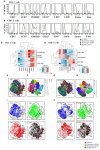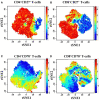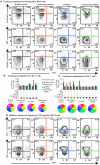Specific Immune Response and Cytokine Production in CD70 Deficiency
- PMID: 33996677
- PMCID: PMC8120026
- DOI: 10.3389/fped.2021.615724
Specific Immune Response and Cytokine Production in CD70 Deficiency
Abstract
Collective clinical and immunologic findings of defects in the CD27-CD70 axis indicate a primary immunodeficiency associated with terminal B-cell development defect and immune dysregulation leading to autoimmunity, uncontrolled viral infection, and lymphoma. Since the molecular mechanism underlying this entity of primary immunodeficiency has been recently described, more insight regarding the function and profile of immunity is required. Therefore, this study aimed to investigate stimulated antibody production, polyclonal vs. virus-specific T-cell response, and cytokine production of a CD70-deficient patient reported previously with early-onset antibody deficiency suffering from chronic viral infections and B-cell lymphoma. The patient and her family members were subjected to clinical evaluation, immunological assays, and functional analyses. The findings of this study indicate an impaired ability of B cells to produce immunoglobulins, and a poor effector function of T cells was also associated with the severity of clinical phenotype. Reduced proportions of cells expressing the memory marker CD45RO, as well as T-bet and Eomes, were observed in CD70-deficient T cells. The proportion of 2B4+ and PD-1+ virus-specific CD8+ T cells was also reduced in the patient. Although the CD70-mutated individuals presented with early-onset clinical manifestations that were well-controlled by using conventional immunological and anticancer chemotherapies, with better prognosis as compared with CD27-deficient patients, targeted treatment toward specific disturbed immune profile may improve the management and even prevent secondary complications.
Keywords: CD70 deficiency; Eomes; PD-1; T-bet; class-switching recombination; inborn errors of immunity; primary immunodeficiency.
Copyright © 2021 Abolhassani.
Conflict of interest statement
The author declares that the research was conducted in the absence of any commercial or financial relationships that could be construed as a potential conflict of interest.
Figures






Similar articles
-
Combined immunodeficiency and Epstein-Barr virus-induced B cell malignancy in humans with inherited CD70 deficiency.J Exp Med. 2017 Jan;214(1):91-106. doi: 10.1084/jem.20160849. Epub 2016 Dec 23. J Exp Med. 2017. PMID: 28011864 Free PMC article.
-
Extended clinical and immunological phenotype and transplant outcome in CD27 and CD70 deficiency.Blood. 2020 Dec 3;136(23):2638-2655. doi: 10.1182/blood.2020006738. Blood. 2020. PMID: 32603431 Free PMC article. Clinical Trial.
-
Inherited CD70 deficiency in humans reveals a critical role for the CD70-CD27 pathway in immunity to Epstein-Barr virus infection.J Exp Med. 2017 Jan;214(1):73-89. doi: 10.1084/jem.20160784. Epub 2016 Dec 23. J Exp Med. 2017. PMID: 28011863 Free PMC article.
-
Timing and tuning of CD27-CD70 interactions: the impact of signal strength in setting the balance between adaptive responses and immunopathology.Immunol Rev. 2009 May;229(1):216-31. doi: 10.1111/j.1600-065X.2009.00774.x. Immunol Rev. 2009. PMID: 19426224 Review.
-
Therapeutic targeting of CD70 and CD27.Expert Opin Ther Targets. 2016 Aug;20(8):959-73. doi: 10.1517/14728222.2016.1158812. Epub 2016 Mar 15. Expert Opin Ther Targets. 2016. PMID: 26914723 Review.
Cited by
-
Cancer Trends in Inborn Errors of Immunity: A Systematic Review and Meta-Analysis.J Clin Immunol. 2024 Oct 28;45(1):34. doi: 10.1007/s10875-024-01810-w. J Clin Immunol. 2024. PMID: 39466473
-
Altered CD27-related T cell subsets reflect immune imbalance in systemic lupus erythematosus.Immunol Res. 2025 May 17;73(1):83. doi: 10.1007/s12026-025-09637-2. Immunol Res. 2025. PMID: 40381105
-
Gene Expression of CD70 and CD27 Is Increased in Alopecia Areata Lesions and Associated with Disease Severity and Activity.Dermatol Res Pract. 2022 Mar 8;2022:5004642. doi: 10.1155/2022/5004642. eCollection 2022. Dermatol Res Pract. 2022. PMID: 35300124 Free PMC article.
-
SARS-CoV-2-Induced Immunosuppression: A Molecular Mimicry Syndrome.Glob Med Genet. 2022 Jul 14;9(3):191-199. doi: 10.1055/s-0042-1748170. eCollection 2022 Sep. Glob Med Genet. 2022. PMID: 35846107 Free PMC article.
-
CD70 recruitment to the immunological synapse is dependent on CD20 in B cells.Proc Natl Acad Sci U S A. 2025 Apr 22;122(16):e2414002122. doi: 10.1073/pnas.2414002122. Epub 2025 Apr 15. Proc Natl Acad Sci U S A. 2025. PMID: 40232798 Free PMC article.
References
-
- Tangye SG, Al-Herz W, Bousfiha A, Chatila T, Cunningham-Rundles C, Etzioni A, et al. . Human inborn errors of immunity: 2019 update on the classification from the international union of immunological societies expert committee. J Clin Immunol. (2020) 40:24–64. 10.1007/s10875-019-00737-x - DOI - PMC - PubMed
LinkOut - more resources
Full Text Sources
Other Literature Sources
Research Materials

